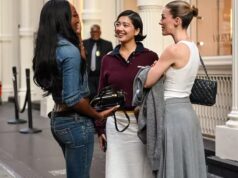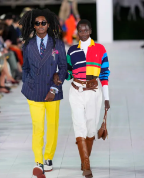“Growing up in South Florida, fashion wasn’t really a thing,” 33-year-old designer Taylor Dorry deadpans via video link from her home studio. Her Zoom backdrop is a rack of one-of-a-kind babydoll dresses, each painstakingly handcrafted from reclaimed upholstery fabrics and fit for a maverick, modern-day princess. Born and raised in beachside Hollywood (Florida, not California), the story behind Dorry’s eponymous label aptly has all the hallmarks of a silver-screen fairytale. Her entirely upcycled designs — which are about to blow up on social media in a big way — almost didn’t happen at all.
For years, she hid her fashion zeal and detoured into political science, all while secretly amassing a superlative vintage archive. “I had these incredible pieces that I would feel uncomfortable wearing out,” Dorry says, adjusting her large aviator spectacles. Her days as a wallflower were numbered, however. (Today, she’s wearing one of her signature pieces — “a thrifted hotel bed cover that I turned into a loose-fit babydoll top” — over a metal band T-shirt.) Soon, she’d relocated to Miami to work as a stylist’s assistant, where her eye for scene-stealing vintage fostered a successful side hustle.
“I was hooked on how special those clothes can make you feel and went from sourcing items for fashion shoots to selling. The pieces that I loved the most made me feel nostalgic in a way that took me back to when I was a little girl trying on my mom’s clothes,” she tells Vogue.
The aesthetic evolved into a business plan and she enrolled on a fashion design course. “I kept picturing a young girl with, like, ratty sneakers and knots in her hair trying on her mom’s 1980s sequin puff-sleeve dress and feeling so special. That was exactly it — I wanted to recreate that childlike femininity that goes away as you get older,” Dorry adds. “From the first day at school, I knew exactly what I wanted to learn. ‘Um, where’s the part about puff sleeves? And how do I make this dress, like, five times the width?’” she laughs (her aridly dry sense of humor on the brand’s IG is, by the way, another big selling point).
By May 2020, she’d opened her virtual shop and launched her one-woman enterprise. Right now, she’s making everything herself. “As everything’s upcycled, I spend a lot of time at thrift stores and estate sales, finding the perfect fabrics to blend together.”
It wasn’t long before her ballooning silhouettes took flight on social media — actor Zaina Miuccia was an early adoptee, sporting Dorry’s head-turning ‘Sophia’ dress with padded pink flip-flops on the streets of New York. (Artist Chloe Wise, musician Lou Doillon, photographer Bella Newman and model Fiffany Luu are also fans.)
For the record, Dorry doesn’t do things by halves. The Sophia babydoll uses almost five yards of vintage fabric. Elsewhere in the collection, there’s the bell-shaped Lola dress, which consumes 18ft of fabric within its ruffle hem (both are currently sold out). “Around 8,000 people asked me about my dress today,” Miuccia wrote on Instagram. “I love how special they make you feel. Everyone notices you, in all the right ways,” the designer agrees — which will be music to the ears of anyone currently dressing their way out of the black hole of human socialization that was 2020.
Meanwhile, on the subject of scale, Dorry is mindful that her approach to sourcing vintage fabrics respects the needs of the wider thrifting community. “When I go to thrift stores, I am not one to clean out the whole aisle of sheets or curtains because people need sheets and curtains for $3 — I impose strict caps for each thrift store. Plus, I don’t usually buy any fabric less than 20 years old.”
She is also on track to launching her first capsule collection towards the end of 2021, which will see her current one-off upcycled pieces accompanied by a line of sustainable and organic clothing. Expect ever-so-slightly fitted dresses and a jumpsuit that riffs off retro Laura Ashley styling.
There’s one other key reference point powering her fashion vision. Is Taylor Dorry’s unshakable cool also about championing the lesser-known facets of Floridan culture as seen through our eyes, the next generation? Dorry nods. “I wasn’t always proud to be born and raised in Florida, only because it tends to be a little crazy down here. The older I got, I realied that Florida is cool in its own right — the sea themes and the beach look can be interpreted in a different way. It is who I am, I’m not going to run from it.”









